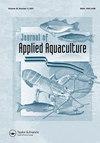不同饲料蛋白质水平对统一足鼠亚成虫养殖的影响:血液学和生化评价
IF 0.8
Q3 FISHERIES
引用次数: 0
摘要
摘要本研究评估了亚成年亚马逊黄斑龟(Podocnemis unifilis)对增加粗蛋白质水平(29%、32%、35%和39% CP)作为膨化商业饲料的生理反应。在饲喂试验的第60、120和180天分别对单根假单胞杆菌的血液学和血浆生化指标进行分析。除了高呼吸爆发活性外,血小板、白细胞、淋巴细胞、嗜白细胞和嗜酸性粒细胞总数的增加表明动物对饮食中增加的蛋白质的免疫防御反应得到改善,共同作用以维持组织对抗抗原和感染因子的完整性。在人工饲养期间,在人工饲料中增加蛋白质水平,增加饲养时间(直到180天)后,观察到亚成虫血浆总胆固醇和甘油三酯水平升高,这是一种营养警告,与身体活动减少有关。根据这些结果,定期进行生理评估对于确保圈养动物的健康和充足的营养条件尤其重要,例如保持较低的动物放养密度以避免压力,并在可能的情况下,除了挤压人工饲料外,还为它们提供新鲜食物。本文章由计算机程序翻译,如有差异,请以英文原文为准。
Different dietary protein levels for Podocnemis unifilis subadult farming: hematological and biochemical assessment
ABSTRACT This study evaluated the physiological responses of subadult yellow-spotted Amazon river turtle, Podocnemis unifilis, to incremental crude protein levels (29%, 32%, 35%, and 39% CP) as extruded commercial feeds. The hematological and plasma biochemical parameters of P. unifilis were analyzed at 60, 120, and 180 days of the feeding trial. The increase in total thrombocyte, leukocyte, lymphocyte, heterophil, and eosinophil numbers, besides high respiratory burst activity showed an improvement in animal immune defense response to incremental protein in diets, acting together to maintain the integrity of the tissues against antigens and infectious agents. Elevated subadult P. unifilis plasma total cholesterol and triglyceride levels observed after increasing the feeding time (until 180 days) with incremented protein levels in artificial diets during captivity are a nutritional warning, related to the condition of being less physically active. Based on these results, periodic physiological evaluations are particularly important to ensure the healthy and adequate nutritional conditions of captive-bred animals, such as maintaining lower stocking densities of animals to avoid stress and, if possible, providing them with fresh food in addition to extruded artificial feed.
求助全文
通过发布文献求助,成功后即可免费获取论文全文。
去求助
来源期刊

Journal of Applied Aquaculture
Environmental Science-Ecology
CiteScore
3.20
自引率
0.00%
发文量
38
期刊介绍:
The Journal of Applied Aquaculture is a platform for the sharing of practical information needed by researchers to meet the needs of investors, farm managers, extension agents and policy makers working to adapt aquaculture theory to achieve economic and food security objectives in the real world. The journal emphasizes multi-disciplinary research and case studies that propose financially and logistically viable solutions to observable problems.
 求助内容:
求助内容: 应助结果提醒方式:
应助结果提醒方式:


